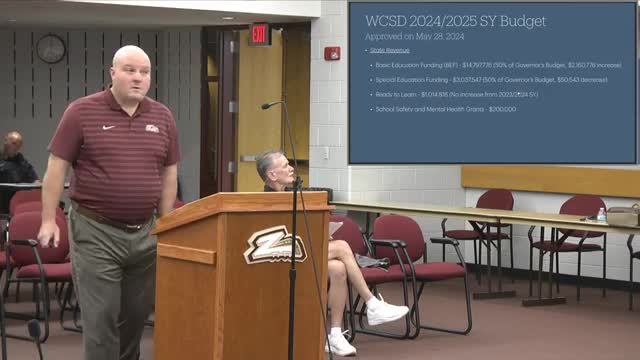School District Secures Major Funding Boost Amid Budget Challenges
July 23, 2024 | Whitehall-Coplay SD, School Districts, Pennsylvania

This article was created by AI summarizing key points discussed. AI makes mistakes, so for full details and context, please refer to the video of the full meeting. Please report any errors so we can fix them. Report an error »

During a recent meeting of the White Elkafi School District Board of School Directors, key updates regarding the district's budget and state funding were discussed. The board approved a budget on May 28, which included significant allocations for basic education funding, special education funding, and mental health initiatives.
The district's basic education funding was set at approximately $14.8 million, reflecting 50% of the governor's proposed budget. Special education funding was budgeted at over $3 million, also at 50% of the governor's recommendation, but this represented a $50,000 decrease from the previous year. The \"Ready to Learn\" funding remained stable at just over $1 million, while school safety and mental health grants were allocated $200,000, consistent with previous years.
On July 11, the Pennsylvania Assembly approved a budget that was notably more timely than the previous year’s, which had seen delays of nearly six months. The district anticipates receiving about $13.8 million in basic education funding, which includes a $650,000 increase from the fair funding formula and an additional $550,000 in hold harmless relief. This hold harmless provision ensures that districts do not receive less funding despite declines in enrollment or changes in property values, although it can divert funds from districts like Whitehall Copley that benefit from the basic education funding formula.
The special education funding is projected to increase to $3.15 million, a rise of $291,000 year-over-year, while the Ready to Learn funding will see a substantial increase of $1.6 million. This increase comes with stipulations on how the funds can be utilized, ensuring they directly impact classroom activities.
Additionally, the district expects to receive approximately $180,000 in cyber charter reimbursements, a modest step towards addressing the financial impact of cyber charter expenses. However, the school safety and mental health grants have seen a slight decrease.
Overall, the district is looking at a $3.2 million increase in state funding compared to the previous year, although this still leaves a $1.6 million deficit in the budget. The board is now tasked with addressing this shortfall while navigating the complexities of state funding allocations.
The district's basic education funding was set at approximately $14.8 million, reflecting 50% of the governor's proposed budget. Special education funding was budgeted at over $3 million, also at 50% of the governor's recommendation, but this represented a $50,000 decrease from the previous year. The \"Ready to Learn\" funding remained stable at just over $1 million, while school safety and mental health grants were allocated $200,000, consistent with previous years.
On July 11, the Pennsylvania Assembly approved a budget that was notably more timely than the previous year’s, which had seen delays of nearly six months. The district anticipates receiving about $13.8 million in basic education funding, which includes a $650,000 increase from the fair funding formula and an additional $550,000 in hold harmless relief. This hold harmless provision ensures that districts do not receive less funding despite declines in enrollment or changes in property values, although it can divert funds from districts like Whitehall Copley that benefit from the basic education funding formula.
The special education funding is projected to increase to $3.15 million, a rise of $291,000 year-over-year, while the Ready to Learn funding will see a substantial increase of $1.6 million. This increase comes with stipulations on how the funds can be utilized, ensuring they directly impact classroom activities.
Additionally, the district expects to receive approximately $180,000 in cyber charter reimbursements, a modest step towards addressing the financial impact of cyber charter expenses. However, the school safety and mental health grants have seen a slight decrease.
Overall, the district is looking at a $3.2 million increase in state funding compared to the previous year, although this still leaves a $1.6 million deficit in the budget. The board is now tasked with addressing this shortfall while navigating the complexities of state funding allocations.
View full meeting
This article is based on a recent meeting—watch the full video and explore the complete transcript for deeper insights into the discussion.
View full meeting